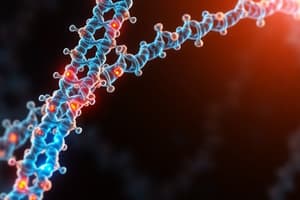Podcast
Questions and Answers
What is the primary mechanism behind immune-mediated myositis in horses following exposure to Streptococcus equi?
What is the primary mechanism behind immune-mediated myositis in horses following exposure to Streptococcus equi?
- The M protein of _S. equi_ shares amino acid sequence similarity to myosin, triggering lymphocyte recruitment and immune-mediated myositis and vasculitis. (correct)
- Toxin production by _Streptococcus equi_ that directly damages muscle fibers.
- Direct bacterial invasion of muscle tissue leading to necrosis.
- Deposition of bacterial antigens in muscle tissue, causing chronic inflammation.
What is the significance of leukocytoclastic inflammation or infarction in the context of Strep-associated myositis?
What is the significance of leukocytoclastic inflammation or infarction in the context of Strep-associated myositis?
- It signifies a non-infectious inflammatory response to muscle trauma.
- It suggests an overproduction of white blood cells, leading to muscle damage.
- It indicates direct bacterial invasion of the muscle tissue.
- It denotes an immune-mediated vasculitis, leading to vessel inflammation and potential tissue death. (correct)
Why are corticosteroids considered contraindicated in the clinical management of Clostridial myonecrosis?
Why are corticosteroids considered contraindicated in the clinical management of Clostridial myonecrosis?
- They exacerbate the anaerobic conditions required for Clostridial proliferation.
- They promote toxin production by Clostridium bacteria, worsening tissue necrosis.
- They suppress the immune system, hindering the body's ability to fight the Clostridial infection. (correct)
- They interfere with the action of penicillin and other antibiotics used to treat the infection.
What pathophysiological mechanism primarily explains the development of HYPP in horses?
What pathophysiological mechanism primarily explains the development of HYPP in horses?
Which diagnostic finding would be most indicative of myositis and infarction in a horse suspected of having immune-mediated muscle disease?
Which diagnostic finding would be most indicative of myositis and infarction in a horse suspected of having immune-mediated muscle disease?
How does the toxin from box elder trees lead to atypical myopathy in horses?
How does the toxin from box elder trees lead to atypical myopathy in horses?
What is the rationale behind using intravenous fluids as a component of treatment for immune-mediated myositis?
What is the rationale behind using intravenous fluids as a component of treatment for immune-mediated myositis?
What key historical or environmental factor is most relevant when diagnosing atypical myopathy associated with box elder ingestion?
What key historical or environmental factor is most relevant when diagnosing atypical myopathy associated with box elder ingestion?
Which of the following best explains why infections with Clostridium spp. lead to myonecrosis?
Which of the following best explains why infections with Clostridium spp. lead to myonecrosis?
Which of the following is the most appropriate treatment strategy for severe HYPP episodes in horses?
Which of the following is the most appropriate treatment strategy for severe HYPP episodes in horses?
What role do resident spores play in the pathogenesis of Clostridial myonecrosis?
What role do resident spores play in the pathogenesis of Clostridial myonecrosis?
What key difference in diagnostic approach distinguishes the identification of immune-mediated myositis causing myositis and infarction from other muscle disorders?
What key difference in diagnostic approach distinguishes the identification of immune-mediated myositis causing myositis and infarction from other muscle disorders?
What is a significant consideration regarding the use of intravenous fluids in treating immune-mediated myositis associated with Streptococcus equi?
What is a significant consideration regarding the use of intravenous fluids in treating immune-mediated myositis associated with Streptococcus equi?
How does the genetic mutation responsible for HYPP primarily affect muscle cell function at the molecular level?
How does the genetic mutation responsible for HYPP primarily affect muscle cell function at the molecular level?
Why is prompt and aggressive fenestration a critical component of clinical management for Clostridial myonecrosis in horses?
Why is prompt and aggressive fenestration a critical component of clinical management for Clostridial myonecrosis in horses?
Why might a horse with Myosin Heavy Chain Myopathy (MYHM) display muscle atrophy?
Why might a horse with Myosin Heavy Chain Myopathy (MYHM) display muscle atrophy?
Considering the pathogenesis of HYPP, which dietary modification would be most appropriate for managing affected horses?
Considering the pathogenesis of HYPP, which dietary modification would be most appropriate for managing affected horses?
What physiological findings would suggest a horse may be suffering from nutritional myodegeneration rather than another form of myopathy?
What physiological findings would suggest a horse may be suffering from nutritional myodegeneration rather than another form of myopathy?
Why is it essential to differentiate between exertional rhabdomyolysis and non-exertional rhabdomyolysis in cases of Myosin Heavy Chain Myopathy (MYHM)?
Why is it essential to differentiate between exertional rhabdomyolysis and non-exertional rhabdomyolysis in cases of Myosin Heavy Chain Myopathy (MYHM)?
Considering the shared clinical signs between HYPP and other conditions, what differentials should be considered in a horse that presents with muscle fasciculations, prolapse of the nictitating membrane, and episodes of muscle weakness?
Considering the shared clinical signs between HYPP and other conditions, what differentials should be considered in a horse that presents with muscle fasciculations, prolapse of the nictitating membrane, and episodes of muscle weakness?
Given the multifactorial nature of Clostridial myonecrosis, how is it typically initiated?
Given the multifactorial nature of Clostridial myonecrosis, how is it typically initiated?
In cases of suspected immune-mediated myositis, what laboratory finding would strongly support a diagnosis of myositis and infarction?
In cases of suspected immune-mediated myositis, what laboratory finding would strongly support a diagnosis of myositis and infarction?
Which factor is most critical in influencing the prognosis of a horse diagnosed with atypical myopathy due to box elder ingestion?
Which factor is most critical in influencing the prognosis of a horse diagnosed with atypical myopathy due to box elder ingestion?
How does the disruption of cellular metabolism due to atypical myopathy affect the clinical presentation of affected horses?
How does the disruption of cellular metabolism due to atypical myopathy affect the clinical presentation of affected horses?
Which statement accurately reflects the genetic basis of Hyperkalemic Periodic Paralysis (HYPP) in Quarter Horses?
Which statement accurately reflects the genetic basis of Hyperkalemic Periodic Paralysis (HYPP) in Quarter Horses?
What is the significance of identifying "resident spores" in muscle tissue when diagnosing Clostridial myonecrosis?
What is the significance of identifying "resident spores" in muscle tissue when diagnosing Clostridial myonecrosis?
How does early recognition and management of clinical signs impact the prognosis of Clostridial myonecrosis in horses?
How does early recognition and management of clinical signs impact the prognosis of Clostridial myonecrosis in horses?
What is the most effective method for preventing future occurrences of atypical myopathy in a herd of horses?
What is the most effective method for preventing future occurrences of atypical myopathy in a herd of horses?
What diagnostic approach is essential for differentiating between immune-mediated myositis and clostridial myonecrosis in horses presenting with acute muscle swelling and pain?
What diagnostic approach is essential for differentiating between immune-mediated myositis and clostridial myonecrosis in horses presenting with acute muscle swelling and pain?
Given the risk factors associated with atypical myopathy, what management strategy should be implemented for horses grazing in sparse pastures during the late fall months?
Given the risk factors associated with atypical myopathy, what management strategy should be implemented for horses grazing in sparse pastures during the late fall months?
What diagnostic finding is most critical in confirming a diagnosis of nutritional myodegeneration in a young foal exhibiting muscle weakness and difficulty swallowing?
What diagnostic finding is most critical in confirming a diagnosis of nutritional myodegeneration in a young foal exhibiting muscle weakness and difficulty swallowing?
How does non-clotting blood relate to a Clostridial infection?
How does non-clotting blood relate to a Clostridial infection?
What is the long-term management strategy for horses diagnosed with HYPP to minimize the risk of future episodes?
What is the long-term management strategy for horses diagnosed with HYPP to minimize the risk of future episodes?
What role does the autonomic nervous system plays in triggering episodes of HYPP in horses?
What role does the autonomic nervous system plays in triggering episodes of HYPP in horses?
What is the aim of clinical management when using penicillin when treating immune-mediated myositis?
What is the aim of clinical management when using penicillin when treating immune-mediated myositis?
What underlying principle guides the current treatment strategies for managing Clostridial myonecrosis in affected horses?
What underlying principle guides the current treatment strategies for managing Clostridial myonecrosis in affected horses?
What factor has been determined to cause Atypical Myopathy?
What factor has been determined to cause Atypical Myopathy?
In a horse diagnosed with Myosin Heavy Chain Myopathy (MYHM) presenting with muscle atrophy, how does the immune system contribute to muscle wasting?
In a horse diagnosed with Myosin Heavy Chain Myopathy (MYHM) presenting with muscle atrophy, how does the immune system contribute to muscle wasting?
How does the toxin produced by the box elder tree (Acer negundo) lead to muscle damage in horses affected by atypical myopathy?
How does the toxin produced by the box elder tree (Acer negundo) lead to muscle damage in horses affected by atypical myopathy?
How does the genetic mutation responsible for Hyperkalemic Periodic Paralysis (HYPP) lead to episodic muscle weakness and paralysis in affected horses?
How does the genetic mutation responsible for Hyperkalemic Periodic Paralysis (HYPP) lead to episodic muscle weakness and paralysis in affected horses?
Considering that resident Clostridium spores may exist in muscle tissue, what specific conditions or factors are most likely to trigger the proliferation and toxin production leading to Clostridial myonecrosis?
Considering that resident Clostridium spores may exist in muscle tissue, what specific conditions or factors are most likely to trigger the proliferation and toxin production leading to Clostridial myonecrosis?
In cases of suspected immune-mediated myositis, what is the clinical significance of identifying a high SeM ELISA titer, such as 1:12,600, in relation to muscle biopsies?
In cases of suspected immune-mediated myositis, what is the clinical significance of identifying a high SeM ELISA titer, such as 1:12,600, in relation to muscle biopsies?
When managing a horse with Hyperkalemic Periodic Paralysis (HYPP), why is it important to consider the impact of dietary potassium levels in conjunction with exercise and stress management?
When managing a horse with Hyperkalemic Periodic Paralysis (HYPP), why is it important to consider the impact of dietary potassium levels in conjunction with exercise and stress management?
Given that atypical myopathy is linked to hypoglycin A from box elder trees, which of the following grazing management strategies would be most effective in reducing the risk of horses ingesting the toxin?
Given that atypical myopathy is linked to hypoglycin A from box elder trees, which of the following grazing management strategies would be most effective in reducing the risk of horses ingesting the toxin?
In cases of Clostridial myonecrosis, what is the relationship between prompt fenestration and antimicrobial therapy in preventing systemic complications?
In cases of Clostridial myonecrosis, what is the relationship between prompt fenestration and antimicrobial therapy in preventing systemic complications?
What is the underlying immunological mechanism that leads to muscle damage in horses with immune-mediated myositis following exposure to Streptococcus equi?
What is the underlying immunological mechanism that leads to muscle damage in horses with immune-mediated myositis following exposure to Streptococcus equi?
In the diagnostic workup for a foal suspected of having nutritional myodegeneration, which combination of clinical signs and laboratory findings would be most indicative of selenium and/or vitamin E deficiency?
In the diagnostic workup for a foal suspected of having nutritional myodegeneration, which combination of clinical signs and laboratory findings would be most indicative of selenium and/or vitamin E deficiency?
Considering the pathophysiology of Clostridial myonecrosis, what is the most important rationale for avoiding the use of corticosteroidsin horses affected by this disease?
Considering the pathophysiology of Clostridial myonecrosis, what is the most important rationale for avoiding the use of corticosteroidsin horses affected by this disease?
When evaluating the prognosis of a horse diagnosed with atypical myopathy, what factor most critically influences the outcome, assuming treatment is initiated promptly?
When evaluating the prognosis of a horse diagnosed with atypical myopathy, what factor most critically influences the outcome, assuming treatment is initiated promptly?
In a horse diagnosed with immune-mediated myositis and vasculitis associated with Streptococcus equi, how does the assessment of ventral edema contribute to understanding the disease?
In a horse diagnosed with immune-mediated myositis and vasculitis associated with Streptococcus equi, how does the assessment of ventral edema contribute to understanding the disease?
Considering the clinical management of mild to moderate Hyperkalemic Periodic Paralysis (HYPP) episodes, how does the administration of grain or corn syrup address the acute problem of hyperkalemia?
Considering the clinical management of mild to moderate Hyperkalemic Periodic Paralysis (HYPP) episodes, how does the administration of grain or corn syrup address the acute problem of hyperkalemia?
What is the role of M protein of Streptococcus equi in the development of Strep-associated Myositis?
What is the role of M protein of Streptococcus equi in the development of Strep-associated Myositis?
Flashcards
What is Strangles?
What is Strangles?
Infection by Streptococcus equi subspecies equi, often leading to abscess formation in the lymph nodes of the head and neck.
What is Myositis?
What is Myositis?
An inflammatory condition of the muscles, often caused by an immune response or infection.
What is Myosin Heavy Chain Myopathy (MYHM)?
What is Myosin Heavy Chain Myopathy (MYHM)?
A muscle disease in Quarter Horses and related breeds associated with the MYH1 gene, often leading to muscle atrophy.
What is Non-exertional Rhabdomyolysis?
What is Non-exertional Rhabdomyolysis?
Signup and view all the flashcards
What is Leukocytoclastic Inflammation?
What is Leukocytoclastic Inflammation?
Signup and view all the flashcards
What is Vasculitis?
What is Vasculitis?
Signup and view all the flashcards
What is Clostridial Myonecrosis?
What is Clostridial Myonecrosis?
Signup and view all the flashcards
What is Crepitation?
What is Crepitation?
Signup and view all the flashcards
What is Hyperkalemic Periodic Paralysis (HYPP)?
What is Hyperkalemic Periodic Paralysis (HYPP)?
Signup and view all the flashcards
What are Muscle Fasciculations?
What are Muscle Fasciculations?
Signup and view all the flashcards
What is Atypical Myopathy?
What is Atypical Myopathy?
Signup and view all the flashcards
What is Nutritional Myodegeneration?
What is Nutritional Myodegeneration?
Signup and view all the flashcards
Study Notes
Additional Muscle Diseases in Horses
- Various muscle diseases can affect horses, including infectious, heritable, toxic, and nutritional myopathies.
Immune-Mediated Myositis
- Strains of Streptococcus spp. are associated with immune-mediated myositis.
- Streptococcus equi subsp equi causes Strangles.
- Immune-mediated myositis can be triggered by natural exposure or vaccination.
- Obvious clinical disease might not always be apparent.
- Intranasal vaccination can be performed using a modified live S. equi vaccine.
Myosin Heavy Chain Myopathy (MYHM)
- Myosin Heavy Chain Myopathy (MYHM) affects Quarter Horses and related breeds.
- MYHM is associated with the MYHI gene.
- Can be caused by immune-mediated myositis, characterized by muscle atrophy post autoimmune events.
- Can be caused by Non-exertional rhabdomyolysis and tying up, not associated with exercise.
- Muscle atrophy may or may not be present.
- MYHM has an autosomal codominant inheritance pattern with variable penetrance.
- N indicates a normal gene.
- My refers to Myosin heavy chain myopathy.
- Diagnosed through testing in Quarter Horses and related breeds.
Strep-Associated Myositis
- M protein (S. equi) has an amino acid sequence similar to myosin, leading to lymphocyte recruitment into muscle.
- Immune-mediated myositis and vasculitis can occur.
- Leukocytoclastic inflammation or infarction can occur.
- IgG or IgA mediate this disease.
- Epaxial and gluteal Muscle atrophy can be observed.
- An SeM ELISA test may show a low result of 1:800.
- Cases have shown improvement after 8 weeks of prednisolone therapy.
- In cases of myositis and infarction, SeM ELISA titers can be very high (e.g., 1:12,600).
- Clinical signs to watch out for include severe petechiation and ulcerations.
- Myocardial and skeletal muscle infarction, as well as PTE (Lung in cross section) have been observed.
- Ventral edema may be present due to vasculitis.
- In a complete blood count, fibrinogen levels may be elevated, around 500 mg/dL.
- Serum chemistry analysis showed creatine phosphokinase at 29,336 mmol / L, and AST at 2290 Units/L.
- Treatments may include administering dexamethasone to reduce inflammation (0.1 mg/kg IV daily), and intravenous fluids to treat pigment.
- Potential for pigment-associated nephropathy when administering intravenous fluids, and LRS 2X maintenance with elevated CK.
- Potassium penicillin addresses primary S. equi infections (22,000 IU/KG IV QID).
- Gastroprotectants, like Omeprazole may be administered to treat poor appetite, steroid therapy.
- Response to therapy can be tracked by SeM titers; an example is SeM titer = 1:25,600 [highest possible value reported].
- Further values include, Day 2 CK = 19,425, Day 3 CK = 14,102, Day 4......CK = 59,464.
- Tachycardia (HR = 80 BPM), colicky, severe pain can be observed.
- Post mortem exams may reveal severe muscle infarction.
- Henoch-Schonlein may be observed.
- For Immune-mediated myositis: treatment consists of Corticosteroids: dexamethasone (HIGH DOSE) 0.2 mg/kg IV daily, Concurrent penicillin therapy, a Mild sedative and analgesic therapy such as Diazepam and butorphanol to manage anxiety and pain
Clostridial Myonecrosis
- This condition that is also known as malignant edema or gas gangrene.
- Bacteria involved include Clostridium perfringens, C. septicum, C. novyi, C. sordelli, and C. chauvoei.
- This is exacerbated by Obligate anaerobic environments, trauma, punctures, High pH, low oxidative potential.
- Spores may exist in muscle tissue, toxin production impairs cellular activity causing severe tissue necrosis.
- Diagnosis is achieved through: Clinical signs and history, non-clotting blood.
- Further diagnostics include: Malodorous fluid, Cytologic analysis via FNA, Anaerobic culture, Fluorescent antibody identification.
- Pain, swelling, and crepitation can be observed.
- Signs include: Poor appetite, Pyrexia, onset generally 48-72 hours after insult.
- This infection can be caused by various factors:
- Various Clostridial spp. infection, Vaccination
- Substances irritating given via intramuscular route
- Such as: Flunixin meglumine, vitamin injections, ivermectin (1980s)
- Spores can be present in muscle tissue; an anaerobic environment and tissue trauma support germination and proliferation.
- Clinical signs can develop rapidly, within 48 to 72 hours, leading to death if underestimated.
- Hematology may show: elevated WBC and neutrophilia, Hyperfibrinogenemia, elevated muscle enzymes, Azotemia, and dehydration.
- Management includes: Fenestration, aggressive fenestration, intravenous fluid therapy.
- Systemic antimicrobial therapy.
- Penicillin at a high dose of 44,000 IU/kg
- Metronidazole
- Oxytetracycline
- Antiinflammatory therapy using corticosteroids is contraindicated.
Genetic Diseases
- Hyperkalemic Periodic Paralysis (HYPP), Atypical (seasonal) myopathy, and Nutritional myodegeneration are muscle diseases in horses.
Hyperkalemic Periodic Paralysis (HYPP)
- HYPP primarily affects Quarter Horses.
- The condition is traced back to descendants of a horse named Impressive.
- HYPP was first identified in horses in 1985.
- In humans it is called Adynamia episodica hereditaria, and Gamstorp’s disease.
- Clinical signs of HYPP include, Twitching, Muscle fasciculations, and Prolapse of the nictitating membrane.
- Manifestations of HYPP can be confused with other conditions, including, Colic, exertional rhabdomyolysis, laminitis, cardiac disease, seizures, tetanus, and esophageal obstruction.
- The onset of symptoms occurs at around 2 to 3 years of age.
- Males are affected more often than females.
- Episodes typically last 15 to 90 minutes.
- Stress is a common trigger.
- Pathogenesis
- Caused by Sodium ion channel mutation, Cytosine to guanine substitution
- Coding: leucine instead of phenylalanine
- Results in increased intercellular sodium.
- Loss of electrical gradient, Channels remain open or re-open frequently
- Low resting membrane potential resulting in K+ leakage from the cell
- Risk factors include Diet that are high in potassium, > 1.1 %, Alfalfa, Molasses, Electrolyte supplementation, Anesthesia, Sedation, and Stress
- Diagnosis
- During an episode:
- Serum potassium can be measured, levels of 5-12 mEq/L (affected horses) vs N = 2.5-4.0 (normal).
- Normokalemic variant can be observed.
- At baseline:
- DNA testing can be performed.
- KCl challenge is another diagnostic option, Enteral 88-160 mg/kg
- EMG can be run.
- During an episode:
- Clinical Management for mild/ moderate disease consists of:
- Grain or corn syrup increases insulin secretion.
- Acetazolamide 2.5-3.0 mg / kg PO tid
- With proper management an episode is mostly avoided.
- For severe cases:
- Administer: Calcium gluconate (0.2-0.4 mL/kg) in 5% dextrose, 5% dextrose alone 6 mL/kg IV (500 kg = 3 L IV), Sodium bicarbonate 1-2 mEq / kg.
- Tracheostomy is necessary in severe cases.
- General control measures include:
- Low potassium diet
- Plain grass hay
- Regular exercise or pasture
- Acetazolamide 2.5 mg/kg PO bid
- Hydrochlorthiazide 0.5-1.0 mg/kg PO bid
Acquired: Atypical Myopathy: Box Elder Trees
- Atypical Myopathy or Seasonal Pasture Myopathy (SPM), is usually highly fatal.
- Characterized by acute, severe myonecrosis.
- Primarily occurs in Midwest during fall months, with cool, wet weather.
- Sparse pasture and limited grain put horses at risk.
- Atypical myopathy is a seasonal pasture myopathy with outbreaks during the Fall.
- Related to the Box elder tree and hypoglycin A in maple trees.
- In Europe sycamore maple = A. pseudoplatanus causes deficiencies in multiple acetyl-CoA dehydrogenases (MAD)
- Non-exertional rhabdomyolsysis may result.
- Treatment
- Consists of High volume crystalloid therapy using Balanced electrolyte solution/
- Status of electrolytes should be monitored through Calcium supplementation.
- Supportive care such as NSAIDs and Vitamin E (antioxidant) may be administered.
- Prognosis should be guarded.
Nutritional Myodegeneration
- Also known as White Muscle Disease.
- It is caused by Vitamin E and / or selenium deficiency, commonly affecting foals between birth and 2 months.
- Can cause acute death, evidence of muscle pain or myocarditis, and elevation of CK / AST levels.
- Dysphagia occurs in less severely affected foals.
- Blood analysis often shows Elevated muscle enzymes with serum selenium and E levels below normal.
Summary of Muscle Diseases
- Myosin Heavy Chain Myopathy (MYHM): This genetic muscle disease is characterized by marked muscle atrophy in Quarter Horses and related breeds; it can be immune-mediated
- Clostridial myonecrosis: Results from the proliferation of Clostridium organisms in muscle tissue, often from resident spores or inoculation.
- HYPP: A heritable condition in Quarter Horses with significant economic impact on the breed due to an autosomal dominant inheritance.
- Box elder ingestion: Results in a toxic myositis known as atypical myopathy, which can be life-threatening.
- Nutritional myodegeneration: A serious condition of foals in geographic regions of selenium deficiency.
Studying That Suits You
Use AI to generate personalized quizzes and flashcards to suit your learning preferences.




